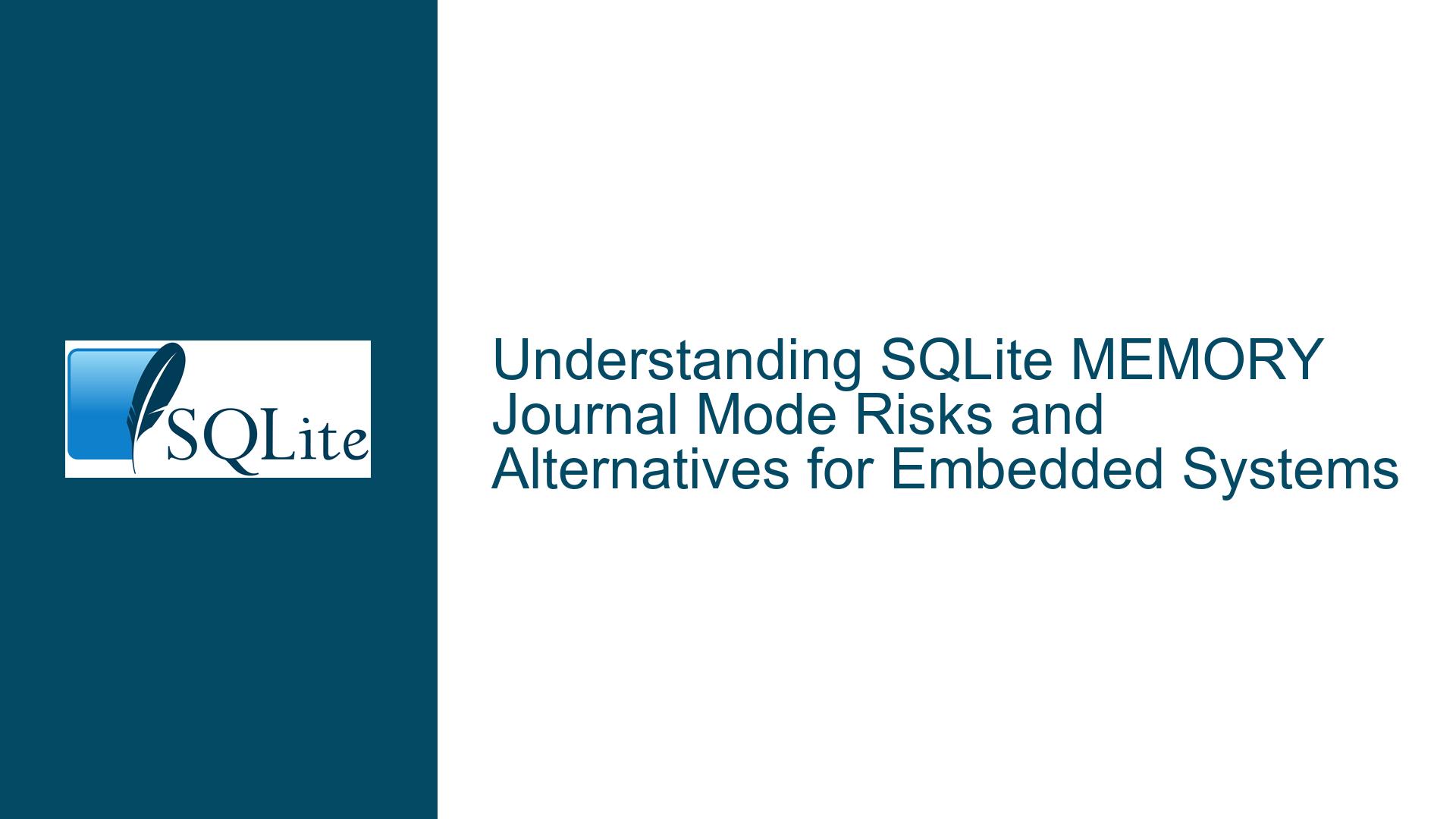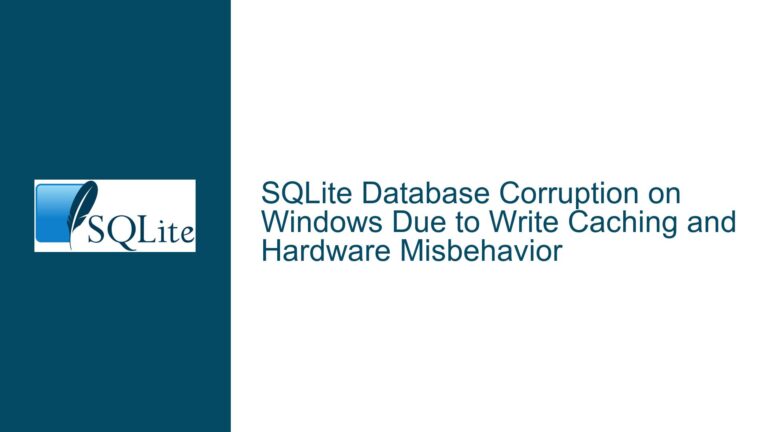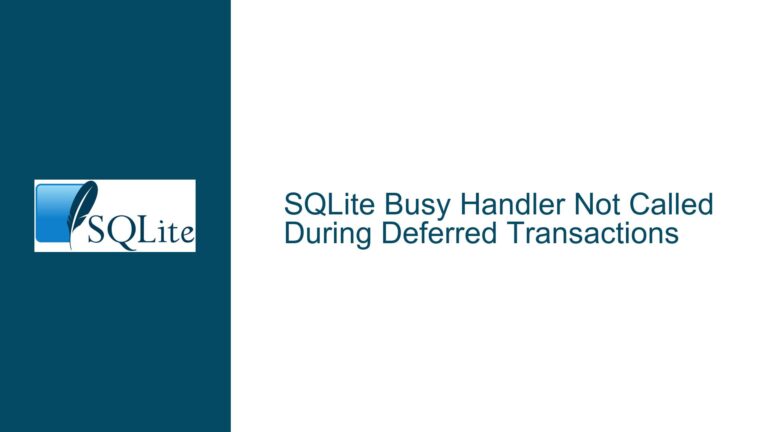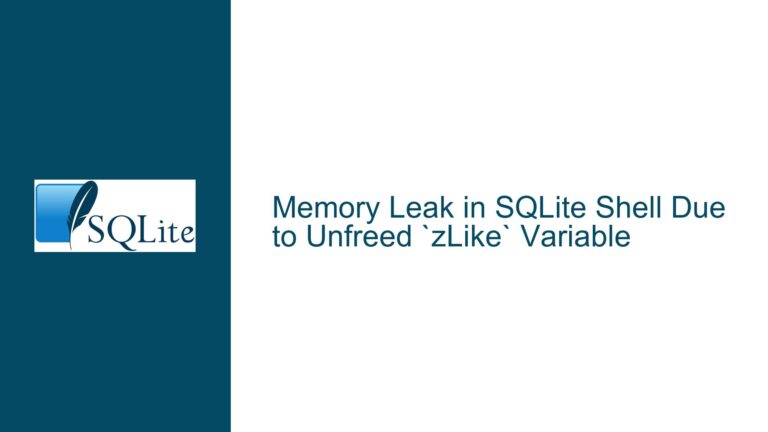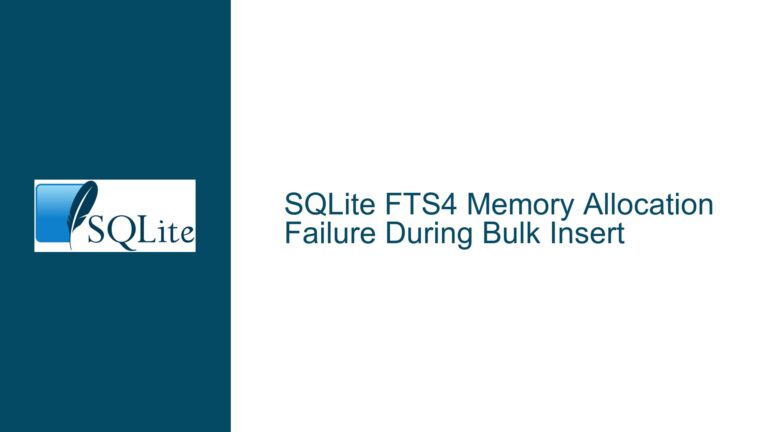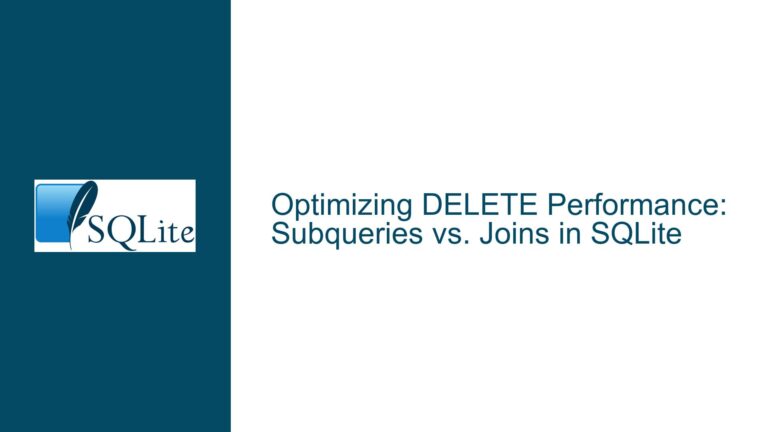SQLite MEMORY Journal Mode Risks and Alternatives for Embedded Systems
The Risks of Using MEMORY Journal Mode in SQLite for Embedded Systems with Frequent Power Loss
SQLite is a widely used database engine, especially in embedded systems, due to its lightweight nature and ease of integration. However, when dealing with environments where power loss is frequent, such as in embedded systems, the choice of journal mode becomes critical. The MEMORY journal mode, while offering significant performance benefits, introduces substantial risks of database corruption in the event of power loss. This post delves into the specifics of why MEMORY journal mode is risky, the underlying mechanisms of SQLite’s journaling, and provides detailed troubleshooting steps and alternative solutions to mitigate these risks.
How SQLite Journal Modes Safeguard Against Data Corruption
SQLite employs various journal modes to ensure data integrity, especially during write operations. The primary purpose of these journal modes is to provide a mechanism for atomic commits and rollbacks, ensuring that the database remains in a consistent state even if a transaction is interrupted. The default journal mode, DELETE, works by creating a temporary journal file that contains the original state of the database pages being modified. If the transaction is completed successfully, the journal file is deleted. If the transaction is interrupted, SQLite uses the journal file to roll back the changes, ensuring that the database remains consistent.
The MEMORY journal mode, on the other hand, stores the journal in memory rather than on disk. This significantly speeds up write operations because it eliminates the need for disk I/O during journaling. However, this speed comes at a cost: if the system loses power during a transaction, the in-memory journal is lost, and there is no way to recover the original state of the database. This can lead to partial writes, where some pages are updated while others are not, resulting in a corrupted database.
The risks associated with MEMORY journal mode are particularly pronounced in embedded systems, where power loss is a common occurrence. In such environments, the database is often stored on non-volatile memory such as NAND flash or USB drives, which can have slower write speeds compared to traditional hard drives. The temptation to use MEMORY journal mode to improve performance is understandable, but the potential for data corruption makes it a risky choice.
The Impact of Power Loss on Database Integrity in MEMORY Journal Mode
When a power loss occurs during a write transaction in MEMORY journal mode, the consequences can be severe. Without a journal file on disk, SQLite has no way to recover the original state of the database. This can lead to several scenarios, each of which can result in database corruption:
Partial Writes: If the power loss occurs in the middle of a write operation, some pages may be updated while others are not. This inconsistency can render the database unreadable, as SQLite relies on the integrity of its page structure to function correctly.
Lost Transactions: Any uncommitted transactions that were in progress at the time of the power loss will be lost. While this may not directly corrupt the database, it can lead to data inconsistency, especially if the lost transactions were part of a larger sequence of operations.
Corrupted Indexes: SQLite uses B-trees for indexing, and these structures are highly sensitive to inconsistencies. A partial write can corrupt an index, making it impossible to retrieve data even if the underlying data pages are intact.
File System Corruption: In some cases, the power loss can also corrupt the file system itself, especially if the database is stored on a USB drive or other removable media. This can make it impossible to access the database file at all.
The risks of using MEMORY journal mode are not limited to power loss. Any interruption that prevents the completion of a write transaction, such as a system crash or a software bug, can have the same effect. In embedded systems, where resources are limited and the environment is often less stable than in traditional computing environments, these risks are magnified.
Alternatives to MEMORY Journal Mode for Improving Write Performance in Embedded Systems
Given the risks associated with MEMORY journal mode, it is important to consider alternative strategies for improving write performance in embedded systems. SQLite offers several other journal modes that provide a balance between performance and data integrity:
TRUNCATE Journal Mode: In this mode, the journal file is truncated to zero length instead of being deleted after a successful transaction. This reduces the number of file system operations required, which can improve performance on some systems. However, the journal file is still written to disk, providing a safeguard against data corruption in the event of a power loss.
PERSIST Journal Mode: This mode is similar to TRUNCATE, but instead of deleting or truncating the journal file, it is left in place and its header is overwritten. This can be faster than DELETE mode on some file systems, while still providing the same level of data integrity.
WAL (Write-Ahead Logging) Mode: WAL mode is a more advanced journaling mechanism that can significantly improve write performance, especially in scenarios with high concurrency. In WAL mode, changes are written to a separate log file (the write-ahead log) rather than directly to the database file. This allows multiple readers to access the database simultaneously while a single writer updates the log. WAL mode also provides better performance on systems with slow disk I/O, as it reduces the number of writes to the main database file.
Synchronous Off: Another option for improving write performance is to set the synchronous pragma to OFF. This tells SQLite not to wait for data to be written to disk before continuing with the next operation. While this can improve performance, it also increases the risk of data corruption in the event of a power loss. This option should be used with caution, especially in environments where power loss is frequent.
Batch Writing: If the application performs frequent small writes, consider batching these writes into larger transactions. This reduces the overhead associated with starting and committing transactions, and can significantly improve performance. However, this approach requires careful design to ensure that data is not lost if a transaction is interrupted.
Hardware Considerations: In some cases, the performance bottleneck may be related to the hardware rather than the database configuration. For example, using a faster storage medium, such as an SSD instead of a USB drive, can improve write performance. Additionally, ensuring that the file system is optimized for the specific hardware can also help.
Troubleshooting Steps and Solutions for Database Corruption in Embedded Systems
If you suspect that your database has been corrupted due to the use of MEMORY journal mode or other factors, there are several steps you can take to diagnose and resolve the issue:
Check the Integrity of the Database: SQLite provides a built-in integrity check that can be run using the
PRAGMA integrity_checkcommand. This command scans the database for inconsistencies and reports any issues it finds. If the integrity check fails, it is likely that the database is corrupted.Recover Data from Backups: If you have a recent backup of the database, you can restore it to recover from the corruption. Regular backups are essential in any environment where data integrity is critical, especially in embedded systems where power loss is a common occurrence.
Use the
.recoverCommand: SQLite provides a.recovercommand that can be used to attempt to recover data from a corrupted database. This command reads all available data from the database file and writes it to a new file, skipping over any corrupted pages. While this can recover some data, it is not guaranteed to work in all cases.Analyze the Journal File: If you are using a journal mode other than MEMORY, you may be able to use the journal file to recover from a failed transaction. SQLite automatically uses the journal file to roll back incomplete transactions when the database is opened. If the journal file is intact, it may be possible to recover the database to a consistent state.
Consider Using WAL Mode: If you are not already using WAL mode, consider switching to it. WAL mode provides better performance and data integrity compared to other journal modes, especially in environments with frequent power loss. However, WAL mode requires more disk space and may not be suitable for all applications.
Optimize the File System: If the database is stored on a USB drive or other removable media, ensure that the file system is optimized for the specific hardware. For example, using a journaling file system such as ext4 or NTFS can provide better data integrity compared to FAT32.
Monitor Power Conditions: If power loss is a frequent issue, consider implementing a power monitoring system that can detect when power is about to be lost and take appropriate action, such as flushing pending writes to disk or shutting down the system gracefully.
Use a UPS (Uninterruptible Power Supply): In environments where power loss is a concern, using a UPS can provide a temporary power source that allows the system to complete pending writes and shut down gracefully. This can significantly reduce the risk of data corruption.
Test Under Realistic Conditions: Before deploying your application in a production environment, test it under realistic conditions, including simulated power loss. This can help you identify potential issues and ensure that your database configuration is robust enough to handle real-world scenarios.
Consult the SQLite Documentation: SQLite provides extensive documentation on its journal modes, pragmas, and other configuration options. If you are unsure about the best configuration for your application, consult the documentation or seek advice from the SQLite community.
In conclusion, while MEMORY journal mode can offer significant performance benefits in SQLite, it is not suitable for environments where power loss is a frequent occurrence. The risks of database corruption far outweigh the potential performance gains, and alternative journal modes such as TRUNCATE, PERSIST, and WAL should be considered instead. By understanding the underlying mechanisms of SQLite’s journaling and taking appropriate precautions, you can ensure that your database remains consistent and reliable, even in the face of power loss and other challenges.
